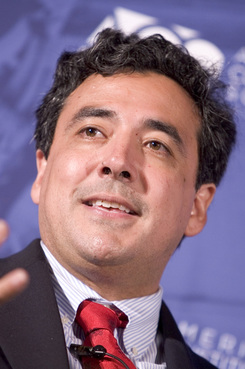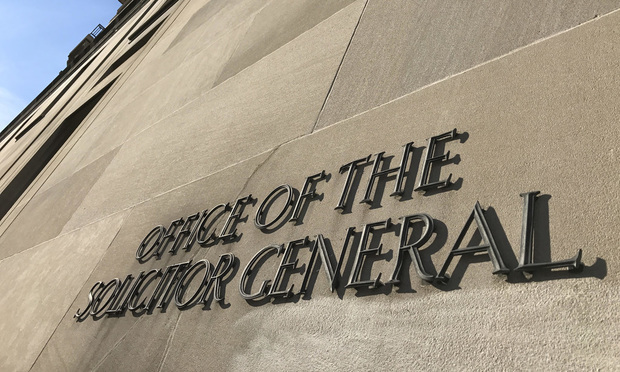 Justice Sonia Sotomayor. Credit: Jason Doiy/ ALM
Justice Sonia Sotomayor. Credit: Jason Doiy/ ALM
During arguments Wednesday in a major Ohio voting challenge, Justice Sonia Sotomayor confronted U.S. Solicitor General Noel Francisco as to why his office broke with solicitors general of both political parties for 24 years who said using failure-to-vote as a trigger to purge voters from state rolls violated the National Voter Registration Act.
Even the Federal Election Commission, nearly a decade after the 1993 enactment of the federal voter registration act, “took the position the old solicitors general were taking,” Sotomayor said. “Everybody but you today come in and say the act before the clarification said something different. Seems quite unusual that your office would change its position so dramatically.”
 Solicitor General Noel Francisco. Credit: Diego M. Radzinschi/ The National Law Journal
Solicitor General Noel Francisco. Credit: Diego M. Radzinschi/ The National Law Journal
Francisco struggled initially to respond to Sotomayor’s question, which marked the first instance a justice has questioned President Donald Trump’s Justice Department about the abandonment of a predecessor’s litigating position.
The U.S. Department of Justice has changed prior administration positions in two other major high court cases this term, one involving the constitutionality of union “fair share” fees, and the other concerning the availability of class actions in worker arbitration agreements under the National Labor Relations Act. The Francisco-led Solicitor General’s Office opposes both.
The National Voter Registration Act and the Help America Vote Act prohibit using a person’s failure to vote as a reason to remove a registered voter from a state’s rolls. But the acts also authorize states, in an effort to keep their rolls current, to remove a voter who fails to respond to a notice seeking confirmation of the voter’s address and fails to vote for four consecutive years. Ohio sends confirmation notices to registered voters who have not voted for two years.
In Wednesday’s arguments, Ohio Solicitor General Eric Murphy and Francisco defended the state’s use of failure to vote for two years as the trigger for sending confirmation notices. They argued that it is not the trigger but, rather, the failure to respond to the confirmation notice and to vote for four consecutive years that results in removal from the registration rolls.
Seventy percent of Ohioans who get those notices do not respond, countered the challenger’s counsel, Paul Smith of Campaign Legal Center. With no evidence that the voter has moved from a district, Smith said, it is the failure to vote alone that removes the voter from the rolls, and that is prohibited by law.
The National Voter Registration Act was enacted in 1993 and was followed in 2002 by the Help America Vote Act—both intended to encourage voting and to make it more accessible.
“After that many presidents, that many solicitor generals, this many years—the vast majority of states, over 35, over 40, actually, who read it the way your opponents read it, most people read it that way—how did the solicitor general change its mind?” Sotomayor asked Francisco again. “Do you believe this doesn’t have an impact, a negative impact on certain groups in this society?”
Francisco said that the Help America Vote Act clarified what was at the time an ongoing debate between the Department of Justice and the states. And he directed her away from legislative history to “public context.”
“Even the most die hard textualists look to the public context in which a law was enacted,” Francisco said. “I refer you to Justice [Antonin] Scalia’s opinion in Branch v. Smith and Professor [John F.] Manning’s article in ‘What Divides Textualists From Purposivists?’ And that public context makes clear that the only thing that was in need of clarification at the time the clarification amendment was passed was precisely this question: whether states like Ohio’s could use a nonvoting trigger in conjunction with the [confirmation notice] process.
“And there’s nothing in this statute that bars that,” Francisco argued. “I think it reflects the balance that Congress was trying to strike in the NVRA between, on the one hand, dramatically increasing the number of voters on the voter rolls but, on the other, giving states the flexibility they need to manage the issues that arise when you have overinflated voter rolls.”
Justice Ruth Bader Ginsburg, apparently not satisfied, also pressed Francisco. “Was it the position of the United States—I thought it was, but you correct me if I’m wrong—I thought that the United States was taking the position, consistently, that nonvoting was not a reliable indicator of residence change.”
Francisco replied that Ginsburg was “partly correct.” The Justice Department, he said, had understood the statute to include a “reliable evidence” requirement and nonvoting was not that kind of reliable evidence.
“Our current position is that when you look at the statute, there’s simply no way to read into it a reliable evidence requirement that’s found nowhere in the text and that Congress, in fact, rejected,” he said.
 U.S. Solicitor General’s Office at Main Justice. Credit: Mike Scarcella/ ALM
U.S. Solicitor General’s Office at Main Justice. Credit: Mike Scarcella/ ALM
The Justice Department’s switch in position spurred competing amicus briefs from former Justice Department leaders and Civil Rights Division officials.
Six former DOJ attorneys supporting Ohio argued that the lower appellate court’s rejection of Ohio’s arguments contradicted how the Justice Department had enforced the voter law historically. “In fact, during amici’s tenures, the Justice Department negotiated settlement agreements that required localities to do exactly what the Sixth Circuit held was illegal here,” said the brief.
Seventeen former department officials, led by former President Barack Obama Attorney General Eric Holder Jr., said in a brief that Francisco “explicitly” stated the change in administration motivated the switch. The Trump DOJ’s position, they said, rejected an interpretation the Justice Department had “repeatedly endorsed” since 1993.
“Unusually, the solicitor general’s brief was not signed by a single career attorney in the Civil Rights Division, the component of the department that is responsible for enforcing the NVRA provisions at issue here,” Samuel Bagenstos wrote in the amicus brief for Holder and the other former officials.
Read more:
US Justice Department Takes Alito’s Side in New Stance Against Union Fees
Trump’s DOJ Switches Sides in Key Labor Case, Now Fights Class Actions
Noel Francisco Will Argue Tricky Voter Case
Supreme Court Takes Antitrust Case the US DOJ Supported, Then Abandoned
US Justice Department Has a Duty to Defend—Only When It Doesn’t


